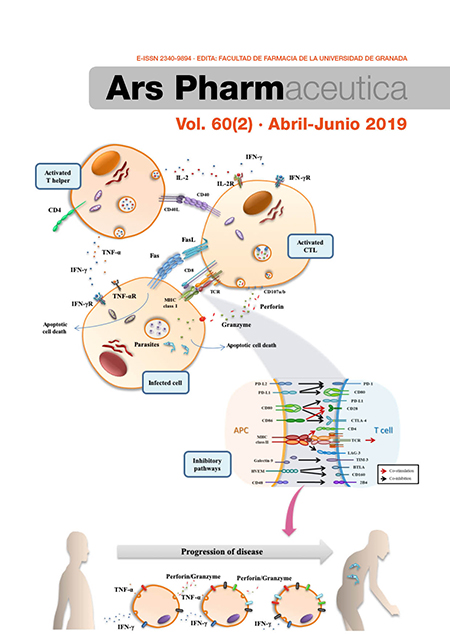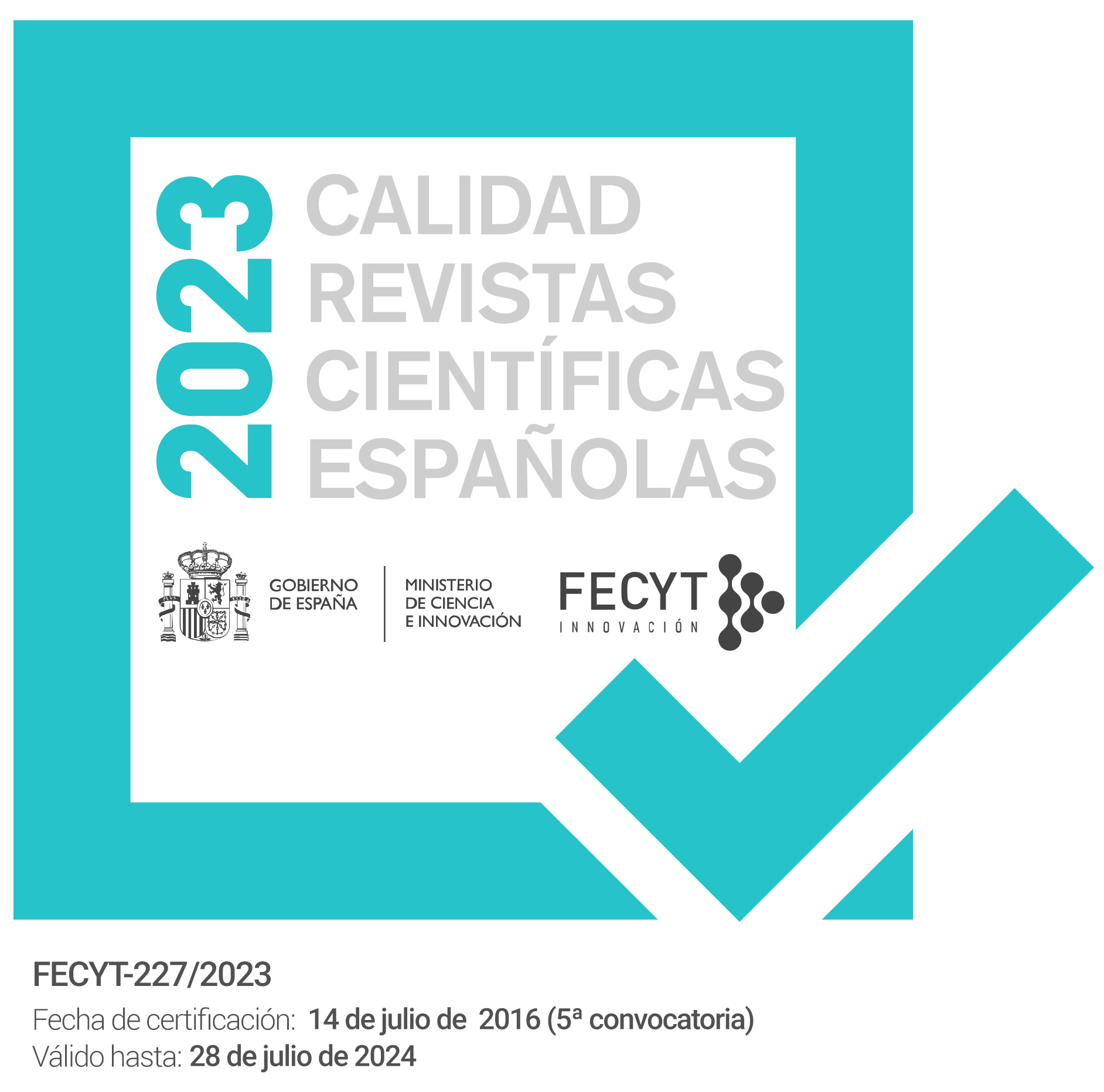Evaluación de dimetilsulfóxido y Aloe vera como potenciadores de la penetración para la aplicación cutánea de lidocaína
DOI:
https://doi.org/10.30827/ars.v60i2.8084Palabras clave:
lidocaína, Aloe vera, Carbopol 934, dimetilsulfoxidoResumen
Objetivo: El objetivo del presente trabajo fue comparar y verificar la eficacia de Aloe vera (1 a 3%) con dimetilsulfoxido (1 a 3%) por su propiedad de mejora de la penetración para la administración tópica de lidocaína.
Método: Carbopol 934 se usó como agente gelificante para la preparación de formulaciones de gel de lidocaína que contenían o no dimetilsulfoxido o Aloe vera (1%, 2% y 3%). Los geles se evaluaron por su aspecto físico, comportamiento reológico, contenido de fármaco, liberación de fármaco y estabilidad.
Resultados: Se dedujo del resultado que la formulación del gel obtenido era adecuada en apariencia, homogeneidad y consistencia. Los perfiles de liberación de fármaco in vitro mostraron que conforme aumentaban el porcentaje de “Aloe vera” en las formulaciones, la tasa de liberación del fármaco se incrementaba sustancialmente. Se observó que la formulación F6 que contenía un 3% de Aloe vera como potenciador de la permeación exhibía un 79,18% de liberación de fármaco. De manera similar, para la formulación F3, que comprendía un 3% de DMSO como potenciador de la permeación, se encontró que la liberación del fármaco era del 84,52%. El uso de Aloe vera puede resultar beneficioso en comparación con los potenciadores de permeación sintéticos.
Conclusión: Sobre la base de los resultados del estudio, se concluyó que el gel tópico de lidocaína preparado junto con Carbopol 934 mediante el uso de Aloe vera como un potenciador natural de la penetración a una concentración del 3%, se puede usar para mejorar la penetración de lidocaína en la piel.
Descargas
Citas
Patil S, Adnaik R, Bhutkar MA, Mohite SK. Formulation and evaluation microemulsion based gel. Int J Uni Pharm Biosci. 2014;3(4):423-435.
Kamble A, Adnaik R, Bhutkar MA. Formulation and evaluation of Itraconazole emulgel for topical drug delivery. Int J Uni Pharm Biosci. 2014;3(5):37-45.
Patil BS, Tanushree S, Tina R, Bhutkar MA, Mohite SK. Formulation and evaluation of transdermal patches of Baclofen. Asian J Pharm Res Develop. 2014;2(5):16-25.
Ogle OE, Mahjoubi G. Local anesthesia: agents, techniques, and complications. Dental Cli North Am. 2012;56(1):133–148. Doi: 10.1016/j.cden.2011.08.003.
Som I, Bhatia K, Mohd. Yasir M. Status of surfactants as penetration enhancers in transdermal drug delivery. J Pharm Bioallied Sci. 2012;4(1):2–9. Doi: 10.4103/0975-7406.92724.
Barry BW. Mode of action of penetration enhancers in human skin. J Control Release. 1987;6:85-97. Doi:10.1016/0168-3659(87)90066-6.
Mutimer MN, Riffikin C, Hill JA, Marry E, Glickman CN. Synthesis of methylsilyl derivates of procaine and their diffusion. J Am Pharm Assoc Sci. 1956;.45:212-8.
Sharma K, Mittal A, Sheikh M, Agrahari P. Investigating the potential of Aloe vera as penetration enhancer for transdermal delivery. Int Bull Drug Res. 2015;5(8):41-50.
Marren K. Dimethyl sulfoxide: an effective penetration enhancer for topical administration of NSAIDs. Physician Sports Med. 2011;39(3):75-82. Doi: 10.3810/psm.2011.09.1923.
Davis J, Rowley S, Braine H, Piantadosi S, Santos G. Clinical toxicity of cryopreserved bone marrow graft infusion. Blood. 1990;75:781–786.
Swanson B. Medical use of Dimethyl sulfoxide (DMSO). Rev Clin Basic Pharmacol. 1985; 5:1–33.
Cavaletti G, Oggioni N, Sala F, Pezzoni G, Cavalletti E, Marmiroli P, Petruccioli MG, Frattola L, Tredici G. Effect on the peripheral nervous system of systemically administered dimethylsulfoxide in the rat: a neurophysiological and pathological study. Toxico Let. 2000;118:103–107.
Franco R, Weiner M, Wagner K, Martelo O. Incorporation of inositol hexaphosphate into red blood cells mediated by dimethyl sulfoxide. Life Science. 1983;32:2763–2768.
Scala K, Antonio V, Kong A. Chemical and physical properties of Aloe vera (Aloe barbadensis Miller) gel stored after high hydrostatic pressure processing. J Food Sci Tech. 2013;33(1):52-59. Doi: 10.1590/S0101-20612013005000002.
Rajeswari R, Umadevi M, Rahale S, Pushpa R, Selvavenkadesh S, Sampath Kumar KP, Bhowmi D. Aloe vera: The miracle plant its medicinal and traditional uses in India. J Pharmacog Phytochem. 2012;1(4):118-124.
Munoz OM, Leal X, Quitral V, Cardemil L. Extraction, characterization and properties of the gel of Aloe vera (Aloe barbadensis Miller) Cultivated in Chile. Med Aromat Plants. 2015;4(3):2-7. Doi:10.4172/2167-0412.1000199.
Mulik M, Phale M. Extraction, purification and identification of aloe gel from Aloe vera (Aloe barbadensis Miller). J Nat Prod. 2009;5(3):111-115.
Background review for sodium laurylsulfate used as an excipient, EMA/CHMP/351898/2014, Published on 23rd July 2015. https://www.ema.europa.eu/en/documents/report/background-review-sodium-laurilsulfate-used-excipient-context-revision-guideline-excipients-label_en.pdf assessed on 15th Dec 2017.
Bhinge SD, Bhutkar MA, Randive DS, Wadkar GH, Todkar SS, Kakade MP, Kadam MP. Formulation development and evaluation of antimicrobial polyherbal gel. Ann Pharm Fr. 2017;75(5):349-358. Doi: 10.1016/j.pharma.2017.04.006.
Bhinge SD, Bhutkar MA, Randive DS, Wadkar GH, Kamble SY, Kalel PD, Kadam SS. Formulation and evaluation of polyherbal gel containing extracts of Azadirachta indica, Adhatoda vasica, Piper betle, Ocimum tenuiflorum and Pongamia pinnata. J Res Pharm. 2019;23(1):44-54. Doi:10.12991/jrp.2018.107.
Marwa HS, Ghada FM. Evaluation of Topical Gel Bases Formulated with Various Essential Oils for Antibacterial Activity against Methicillin Resistant Staphylococcus Aureus. Trop J Pharm Res 2013;12(6):877-884. Doi:10.4314/tjpr.v12i6.3.
Sera UV, Ramana MV. In vitro skin absorption and drug release – a comparison of four commercial hydrophilic gel preparations for topical use. The Indian Pharmacist 2006;73:356-360.
Singh J, Tripathi KP, Sakia TR. Effect of penetration enhancers on the in vitro transport of ephedrine through rat skin and human epidermis from matrix based transdermal formulations. Drug Dev Ind Pharm. 1993;19:1623-8. Doi:10.3109/03639049309069331.
Abou el Ela AEF, Ibrahim EH, Allam AA. Bucco-adhesive tablets containing metoprololtartarate: formulation, in vitro and in vivo characterization. J Drug Deliv Sci Tech. 2013;23:171–179. Doi: 10.1016/S1773-2247(13)50026-8.
Kiran S, Ashu M, Priyanka A. Skin permeation of Candesartan Cilexetil from transdermal patch containing Aloe Vera gel as penetration enhancer. Asian J Pharm. 2016;10 (2):31-43. Doi: 10.22377/ajp.v10i2.611.
Descargas
Archivos adicionales
Publicado
Cómo citar
Número
Sección
Licencia
Los artículos que se publican en esta revista están sujetos a los siguientes términos en relación a los derechos patrimoniales o de explotación:
- Los autores/as conservarán sus derechos de autor y garantizarán a la revista el derecho de primera publicación de su obra, la cual se distribuirá con una licencia Creative Commons BY-NC-SA 4.0 que permite a terceros reutilizar la obra siempre que se indique su autor, se cite la fuente original y no se haga un uso comercial de la misma.
- Los autores/as podrán adoptar otros acuerdos de licencia no exclusiva de distribución de la versión de la obra publicada (p. ej.: depositarla en un archivo telemático institucional o publicarla en un volumen monográfico) siempre que se indique la fuente original de su publicación.
- Se permite y recomienda a los autores/as difundir su obra a través de Internet (p. ej.: en repositorios institucionales o en su página web) antes y durante el proceso de envío, lo cual puede producir intercambios interesantes y aumentar las citas de la obra publicada. (Véase El efecto del acceso abierto).
























